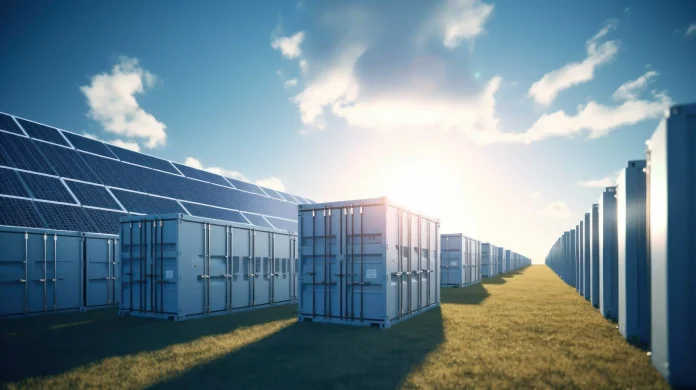As the world pivots toward renewable energy, electric utility storage batteries — massive batteries that store energy from solar, wind, and other sources for later use — are becoming essential to modern power grids. They absorb excess energy generated during peak times and release it when production wanes, making these systems indispensable for achieving 24/7 energy availability from renewable sources. For countries with high renewable energy adoption, grid reliability hinges on the stability of storage solutions.
These batteries bridge the gap between energy production and demand, ensuring stability. Yet, in this rapidly growing market, a handful of Chinese companies — CATL (Contemporary Amperex Technology Co. Ltd), BYD (Build Your Dreams), and REPT (Ruipu Energy Co. Ltd) — dominate global supply, sparking questions about geopolitical leverage, potential vulnerabilities, and the security implications for countries whose diplomatic ties with China are strained.
Globally, China has steadily emerged as the central player in battery manufacturing, claiming an estimated 79% share of worldwide battery production in 2022. CATL, in particular, stands as the world’s largest producer of lithium-ion batteries, with a market share of about 37%. The company supplies batteries for electric vehicles (EVs) and large-scale energy storage systems, partnering with global carmakers such as Tesla, BMW, and Volkswagen. BYD, another significant player with a market share of around 12%, produces both EVs and batteries, boasting an extensive domestic and international client base. BYD’s svelte EVs are now available in India. REPT, a relatively newer entrant, focuses on high-performance storage solutions and has quickly gained traction due to its backing by larger Chinese conglomerates.
Behind the scenes, the Chinese government has played a crucial role in supporting these firms, offering subsidies, incentives, and policy support to ensure dominance in the lithium-ion battery sector. This includes considerable financial and regulatory support for CATL and BYD, positioning them as global leaders in a highly competitive field. This dominant market position now places Chinese companies at the heart of energy security debates, as nations that rely on these companies for grid stability face potential vulnerabilities if geopolitical tensions sour.
The Chinese government’s deep involvement in the battery sector is not incidental. China’s “Made in China 2025” policy has highlighted high-tech sectors, including battery production, as critical to the country’s future economic strength and security. With this support, CATL’s R&D investment and production capabilities are unrivalled. Its revenues topped $35 billion in 2022, a direct result of government sponsorship and a deliberate push to secure energy influence on a global scale.
This reliance level raises red flags for countries like the United States, India, and several European nations. While batteries are fundamentally a non-threatening technology, their role in power storage for electrical grids can make them vital strategic assets. If tensions escalate, there’s a risk that Chinese battery manufacturers could find themselves used as political tools. These batteries are not just storage units but are embedded with intricate software and remote management systems that could potentially serve as vectors for interference in other nations’ critical infrastructures.
Dependence on Chinese batteries is more than an economic concern; it’s a strategic vulnerability. Consider, for example, the US. Some of the largest utility companies in California, Texas, and New York rely on these systems to stabilise their grids during peak demand or adverse weather. A significant portion of the equipment for these systems, including high-capacity batteries and components, is sourced from Chinese manufacturers like CATL. What happens if political relations deteriorate is anyone’s guess.
The potential risks are not limited to trade restrictions or withheld components. Cybersecurity experts warn that remote monitoring capabilities built into these battery storage systems could provide unintended access points for tampering. While such risks are purely speculative today, the possibility of malicious cyber activity cannot be ruled out, especially if diplomatic relations become strained. Think blackouts, disrupted essential services, and millions in damages. This is especially concerning when a country’s energy storage infrastructure depends on the technology of a company operating under a government with possible divergent political interests.
Imagine a scenario where a critical part of the grid becomes compromised. This could result from, say, a withheld component shipment or a software malfunction. A prolonged interruption would not just cause blackouts but could also jeopardise public safety. Transportation, healthcare, emergency response, and communication systems would all suffer. In such an event, cities and towns could find themselves in a state of emergency, unable to perform essential functions, all because a battery storage system was unavailable or inoperable. For countries like the US, with significant grid reliance on renewable energy storage solutions, this concentration of power in the hands of a few foreign entities could quickly transform from an economic inconvenience to a national security emergency.
Acknowledging the strategic vulnerability accompanying dependence on foreign battery manufacturers, several nations are diversifying their energy storage supply chains. The US department of energy has allocated funds to spur domestic battery production and reduce reliance on foreign suppliers. Europe, too, is working on the European Battery Alliance, a collaborative effort among member states to build a homegrown battery supply chain. Japan and South Korea have also been exploring partnerships to expand their battery industries and reduce reliance on Chinese firms.
However, diversification of supply chains is a costly and time-intensive undertaking. The infrastructure, expertise, and raw material access that Chinese firms enjoy make it challenging for other nations to match their production capabilities. Investments in research, development, and skilled labour are necessary to create viable alternatives, but they will take time to bear fruit.
As the demand for sustainable energy storage solutions surges, countries must carefully weigh the benefits of efficient, cost-effective foreign technology against potential vulnerabilities. By securing these energy backbones, the world can transition smoothly into a cleaner, safer, and more resilient energy future.




